

Apple blossom time at Chandler and Dunn at Lower Goldstone, Ash in East Kent
On Tuesday evening, The English Apple Man joined fellow members of East Kent Fruit Society (EKFS) for a farm walk at Chandler & Dunn's Lower Goldstone farm at Ash near Canterbury.
Chandler and Dunn Ltd have been fruit growing and farming at Lower Goldstone for over 200 years. Fruit is grown on two sites, the other farm is 3 miles away at Perry Farm in Wingham. The fruit enterprise is run by Ian, Clive and Peter Chandler.
Below: Alex Cooke - EKFS Chairman
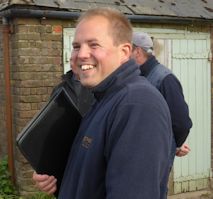 Welcoming a EKFS members to the first meeting of the 2015 season, Society Chairman Alex Cooke said visiting Chandler & Dunn was an excellent start to the 2015 programme of events; over the last decade Lower Goldstone has changed from a traditional fruit business with Cox on MM106, Bramley, Pears and various Plum varieties. In 2015 the farm grows many of the modern varieties becoming popular today and all on M9 rootstock.
Welcoming a EKFS members to the first meeting of the 2015 season, Society Chairman Alex Cooke said visiting Chandler & Dunn was an excellent start to the 2015 programme of events; over the last decade Lower Goldstone has changed from a traditional fruit business with Cox on MM106, Bramley, Pears and various Plum varieties. In 2015 the farm grows many of the modern varieties becoming popular today and all on M9 rootstock.
EKFS farm walks are always well attended and Tuesday evening was no exception, with more than 70 members arriving at Lower Goldstone on a dry and generally sunny evening for a very interesting tour of the orchards.
More than 70 EKFS members turned up at Lower Goldstone on Tuesday evening
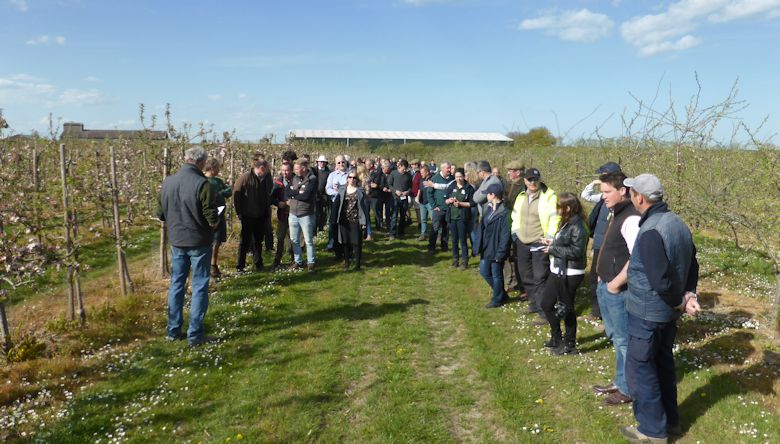
The fruit enterprise which is part of a large farming business consists of 210 hectares of apples, pears and plums.
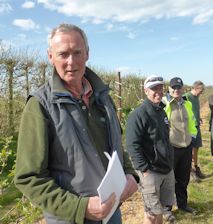 Host for the evening was Clive Chandler who manages the fruit enterprise at Lower Goldstone; Clive explained that the 210 hectares of fruit grown by the Chandler & Dunn family partnership is split between two farms with Perry Fruit Farm at Wingham just 3 miles away the other fruit enterprise.
Host for the evening was Clive Chandler who manages the fruit enterprise at Lower Goldstone; Clive explained that the 210 hectares of fruit grown by the Chandler & Dunn family partnership is split between two farms with Perry Fruit Farm at Wingham just 3 miles away the other fruit enterprise.
Traditionally the farm has grown large areas of Cox, but now heavier cropping varieties are replacing the Cox; Gala, Braeburn, Jazz and even newer varieties like Daliclass, Crimson Crisp and Smitten are central to apple production at C&D. Other varieties like Bramley are still grown.
Pears consist of Conference and Concorde and the plums are Victoria and Opal. Fruit is stored on both sites in refrigerated CA stores. Chandler & Dunn are members of Fruition PO (a growers cooperative) which markets their fruit through Worldwide Fruit Ltd.
The business also farms a similar area of arable crops including Wheat, Barley, peas beans, Oil seed Rape, linseed and potatoes and a pedigree Sussex herd of cattle, comprising 90 single suckler cows. Most of progeny from the cows is sold via the companies own butchers shop on the farm. In total Chandler & Dunn farm circa 200 hectares of fruit; 200 hectares of arable and 200 hectares of grassland grazed by cattle and sheep.
The first orchard on our tour named 'Boxshed' was planted in 2013/14 at a planting distance of 3.5 metres x 1.25 metres (2285 trees per hectare) with no pollinators and Clive anticipates yields of 40 tonnes per hectare by years 3 - 4. The pollinator question; 'should or should not' is often debated, but as Gala tends to produce a crop easily and including pollinators within the planting system has often resulted in an 'over-set' requiring expensive hand thinning, it is not uncommon to plant Gala without pollinators.
Below left: Brookfield Gala in Boxshed Orchard - Below right: Gambrills Jazz
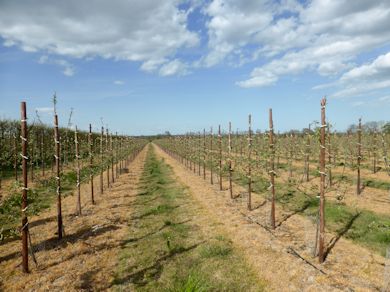
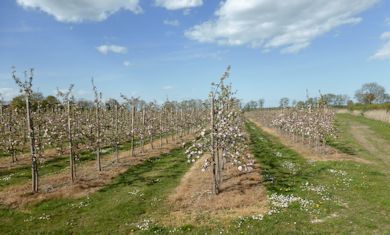
Parrot beak is an irritating problem on young Jazz trees
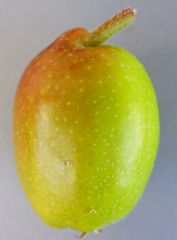 The second orchard; named 'Gambrills' a Jazz orchard planted in 2010/11 at the same spacing as Boxshed. Golden Delicious have been planted as a pollinator, as much for fruit shape as crop load. Jazz has a habit (especially on young trees) for producing 'parrot beak' fruit - however the yields to date are very good; 28 bins per ha in 2012, 70 bins per ha in 2013 and 90 bins (27 tonnes) per ha in 2014.
The second orchard; named 'Gambrills' a Jazz orchard planted in 2010/11 at the same spacing as Boxshed. Golden Delicious have been planted as a pollinator, as much for fruit shape as crop load. Jazz has a habit (especially on young trees) for producing 'parrot beak' fruit - however the yields to date are very good; 28 bins per ha in 2012, 70 bins per ha in 2013 and 90 bins (27 tonnes) per ha in 2014.
Next on our tour; Parasol a more mature Jazz orchard planted in 2005/06. Yields have been reduced due to canker with 5-8% of the trees replaced over the life of the orchard and as Clive Chandler point out, many with canker lesions reducing the capability of infected trees. Yields for the last three years are disappointing when compared to the much younger trees in Gambrills. 57 bins per ha in 2012, 83 bins per ha in 2013 and 86 bins (25.8 tonnes) per ha in 2014.
Clive reflected on his decision to plant Jazz on this site as it had a previous association with Canker; it is easy to be wise after the event and in response to a question; "would you plant Jazz again" he replied - YES but not on a site with a known history of Canker.
Below left: Jazz in Parasol Orchard - Below right: Canker lesion on the trunk of a Jazz tree
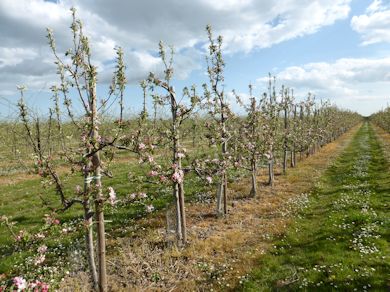
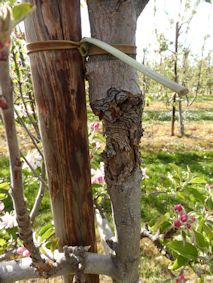
After Parasol we moved onto Solleys; a Braeburn 'Mariri Red' orchard planted in 2007/08 with 1904 trees per hectare (planting distance 3.8 metres x 1.5 metres) - yields for the last three years are: 59 bins per ha in 2012, 199 bins per ha in 2013 and 204 bins (61 tonnes) per ha in 2014.
Clive Chandler commented that with these heavy yields it is important to ensure nutrients used by the trees are replaced; with this in mind he has been applying 100 units of Nitrogen. Regarding thinning, and aware that Braeburn can grow too big if 'over thinned or lacking fruit set due to 'nature's influence' Clive is considering leaving the trees unthinned until he can be sure of the crop load.
Commenting on the next Orchard - 'Grange' Clive said Chandler & Dunn used to be very successful with Cox on MM106 but this orchard - 'the last one planted' in 2002/03 with 666 trees par hectare has not been a success. Clive is 'hovering on the verge' of grubbing it out, but decided to 'give it one more year' - yields in the last three years unimpressive with 55 bins per ha in 2012, 80 bins per ha in 2013 and 95 bins (28.5 tonnes) per ha in 2014. Certainly the lack of crop cannot be down to pollination as Golden Delicious & Ida Red (2 excellent pollinators) supplying the necessary pollination.
Below left: Cox on MM106 rootstock - Below right: Cox at the Pink Bud stage on Tuesday evening
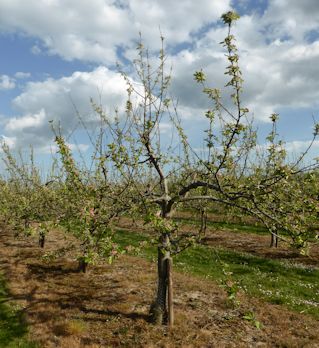
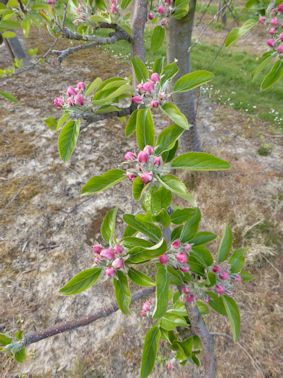
From the Cox we moved onto 'Court' a Bramley Orchard planted on M26 rootstock. Clive Chandler said they have only used a 'chainsaw' to prune the Bramley for the last seven years; using a lightweight chainsaw is quick, and in the hands of an experienced pruner can deliver a very good result. 'Remember, Bramley is a 'tip bearer' so the character of the tree fits perfectly into the chainsaw system on 'mature Bramley' trees.
Below left: Bramley on M26 - Below right: Pruning cuts made with a Chainsaw
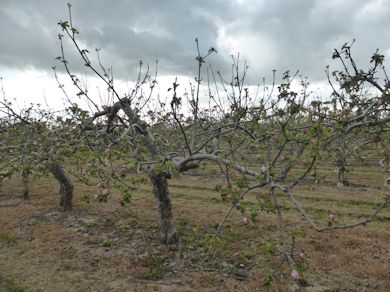
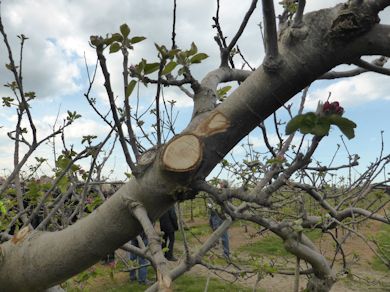
Below: A 'perfectly shaped' Gala Schniga tree
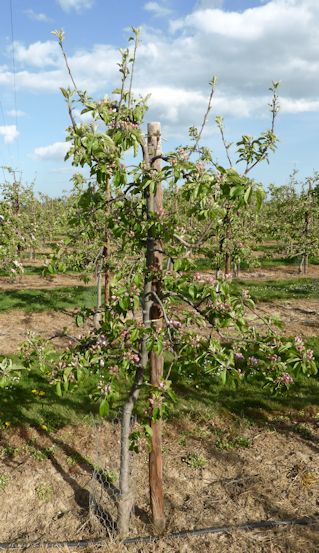 'Coronation Orchard' - Gala Schniga planted in 2007/08 with 1904 trees per hectare was the first coloured Gala clone Clive planted and has produced heavy crops of good quality apples with more fruit in the 1st pick than other Gala clones; 1st pick means the percentage of the crop picked in the first pick of the season; the importance of a high % first pick is the fruit is in perfect condition internally for good storage; second pick will always have less storage capability.
'Coronation Orchard' - Gala Schniga planted in 2007/08 with 1904 trees per hectare was the first coloured Gala clone Clive planted and has produced heavy crops of good quality apples with more fruit in the 1st pick than other Gala clones; 1st pick means the percentage of the crop picked in the first pick of the season; the importance of a high % first pick is the fruit is in perfect condition internally for good storage; second pick will always have less storage capability.
Standing near a Gala Schniga tree, Clive commented - "this is to my mind, a perfectly formed tree" - with its 'precosity' it needs thinning and even with an ATS thinner (Sulphur applied at early blossom) to reduce flower numbers, it is normal to spend £1,000 per hectare on 'hand' thinning.
The Gala Schniga has Golden Delicious as a pollinator; yields are very good with 115 bins per ha in 2012, 150 bins per ha in 2013 and 169 bins (45 tonnes) per ha in 2014.
Melrose Crimson Crisp & Melrose Daliclass
Our final orchard visit took us to the Crimson Crisp and Daliclass orchards; both varieties were planted in 2011/12 and both have 1904 trees per hectare and both produced dominant top branches. Clive noted that where a top was broken off by the wind, the tree settled into a better balance; his intention is to remove the dominant tops in June - 'this is the best time' (around the longest day) to reduce vigorous return growth.
To date the Crimson Crisp yield is : 28 bins per ha in 2013 and 90 bins per ha in 2014. Daliclass yield was 40 bins per ha in 2013 and 112 bins per ha in 2014.
Both varieties recorded impressive yields in the 3rd leaf - 2013; Crimson Crisp = 27 tonnes per hectare and Daliclass = 33.6 tonnes per hectare.
Below left: Crimson Crisp Tree - Below right: Top of Tree
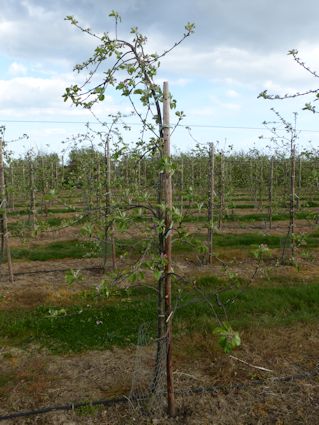
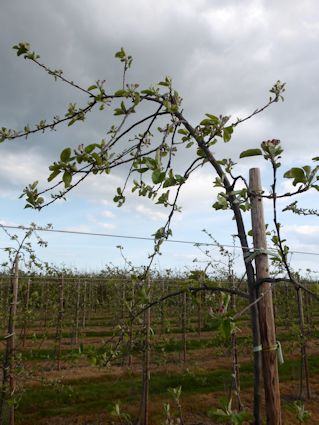
The Chandler & Dunn business is an impressive one, with the combined families of 'Chandler's & Dunn's now farming in the 5th generation and has seven family members still involved in the 'day to day' business.
The English Apple Man highly recommends visitors to the area to take the time to pop into the Goldstone Butchers at Lower Goldstone where Prime Beef, Lamb & Pork - Locally Produced The Natural Way Enhancing the tenderness & succulent flavours of the meat, is available Fresh or Frozen.
Click on Chandler & Dunn to visit Chandler & Dunn website.
Wishing my readers an enjoyable May Bank Holiday weekend...........
Take care
The English Apple Man